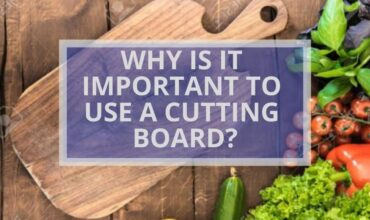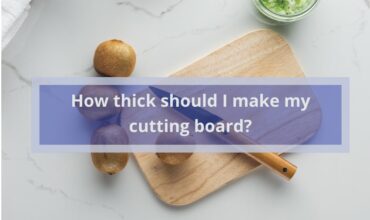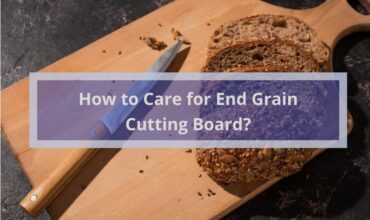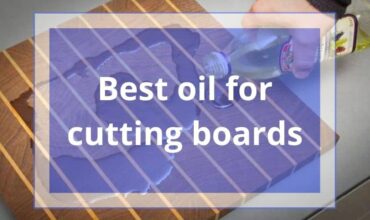If you want to prevent your cutting boards from cracking, splinting or absorbing, moisture, then you should oil them.
Not every natural oil can be used for oiling and maintaining wooden boards. Actually, there are many oils that can go rancid on the cutting board surface, leaving a horrible taste and smell on it.
That’s why we enlisted the best and worst oils you can use for your precious chopping board or wooden utensils.
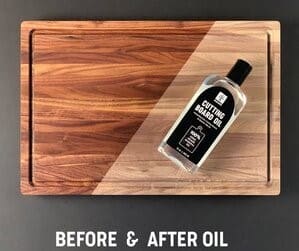
What Is The Best Oil to Use On A Wooden Cutting Board?
Mineral Oil: What mineral oil is food safe?
Mineral oil is colorless, odorless, and flavorless oil derived from petroleum. It is non-toxic and prevents water absorption, which makes it 100% food safe oil.
Mineral oil is the best cutting board oil. it is also a perfect option for wood kitchen utensils as wooden spoons, bowls, butcher blocks, and bamboo wood boards.
Watch Out! Mineral oil has two types, a food grade mineral oil and another type that is not safe for human consumption (this last one can only be used as machinery lubricant).
Watch Out! Mineral oil has two types, a food grade mineral oil and another type that is not safe for human consumption (this last one can only be used as machinery lubricant).
Don’t worry. I will tell you how to determine the safe mineral oil and the not-safe one. Check the product label first. If you found “white mineral oil,” “food grade mineral oil,” or “liquid paraffin” written on it, then it is totally safe.
.Oiling your wooden cutting board regularly with food-grade mineral oil will protect it from getting dry and brittle, prevent cracking, and prevent the wood cutting board from absorbing liquids.
All in all, it has the ability to maintain your wood board for years to come.
To get the most of your mineral oil, apply a generous amount of it on your wooden cutting board using a piece of damp cloth or paper towel. and then leave it for two to four hours until the board will absorb the mineral oil.
Wipe off the excess oil (the oil that wood didn’t absorb) with a dry cloth. and repeat this whenever you find your wooden cutting boards or butcher block are dry.
Read more, 5 Best Knives’ Oil and Lubricant Review
Coconut Oil: Can I use coconut oil on a cutting board?

For those asking, Can I use coconut oil on a cutting board? Here is the answer.
Fractionated coconut is one of the best cutting board oil for maintaining and prolonging its life. just makes sure you are using the fractionated coconut oil (the oil found after removing the fat from the coconut itself).
This oil works just like food grade mineral oil. It is food safe and keeps wooden cutting boards moisturized, which prevents cracks and harmful bacteria. Here is how to use it:
Steps
- Take a teaspoon of the oil.
- Lather it into the cutting board surface with a piece of cloth or your hands. Repeat 3 to 4 times.
- Leave the board overnight to let the oil penetrates deep into the wood.
- On the next day, remove the excess oil.
And voila! Your wood cutting board is super shiny and, most of all, healthy.
If you are confused about whether to rinse the wood cutting board or not, let me tell you something, the oil of coconut is used widely in cooking, just like vegetable oil, which means that you can safely use your board right after conditioning without rinsing.
Does coconut oil go rancid?
Yes! That’s why you should only use fractionated coconut oil, because the regular oil found in the market has fat, and this fat can get rancid.
Linseed Oil : Can I use linseed oil on a cutting board?
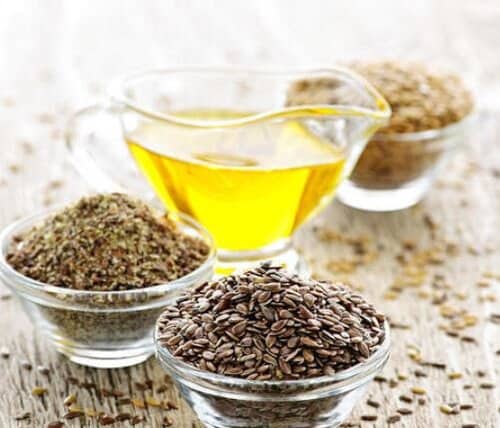
Linseed comes from the flax plant. It is food safe, water-repel, and shiny.
You need to keep an eye on where you get the linseed oil, as it is sometimes treated with toxic chemicals.
Linseed oil is organic oil and organic oils can go rancid. but in fact, this suitable for wood oil doesn’t go rancid as fast as all other oils, which makes it safe to deal with cutting boards and butcher blocks.
Don’t ever use boiled linseed oil. it is not good for boards.
Walnut Oil

Walnut oil comes from the English walnuts. it is so popular because it doesn’t go rancid fast, just like linseed oil.
Keep in mind that walnut oil comes from a nut, so if you are allergic to nut or nut oil, you should find another alternative from the above.
Walnut oil also treats odors on the cutting board as it smells so good.
The drawback is it is pretty expensive and might have a tacky feel and sticky coating. but you can handle this by washing the board with hot water.
Read more , The 5 Best Ceramic Folding Knife /Pocket Knife Review
Tung Oil
It comes from the Tung trees in southern China. It dries, which won’t make it go rancid, and won’t create a sticky coat. It will give the board a satin and golden tint look.
For better results, coat and dry your cutting board for seven days a row.
Be careful as some people are allergic to pure tung oil.
Other Natural Materials for Maintaining Cutting Boards And Butcher Blocks
Beeswax: Is Beeswax Safe For Food?

It is excellent for conditioning and maintaining butcher blocks and wood cutting boards. and it hydrates (moisturizes), shines, and waterproofs them. So the answer is yes, it is food safe (obviously!)
Regular application of beeswax can keep your cutting board (especially a bamboo chopping board) shiny and hygenic.
Applying beeswax confuses many people since it is known to be solid. so here is a lifesaving secret, mix beeswax with the odorless food-grade mineral oil (for added water resistance) or oil coconut (for added hydration). then heat the mixture.
Apply the mixture on the cutting board and leave overnight, and then wipe the excess oil
The quantities should be as follows: the mineral oil should be double the quantity of beeswax, and coconut should be four times more than it.
By this, you will be hitting two birds with one stone, as you’ll make it easier for the board to absorb the beeswax and benefit from the oil benefits.
Check also, 10 Best Electric Bread Slicer | Buyer’s Guide
Carnauba wax
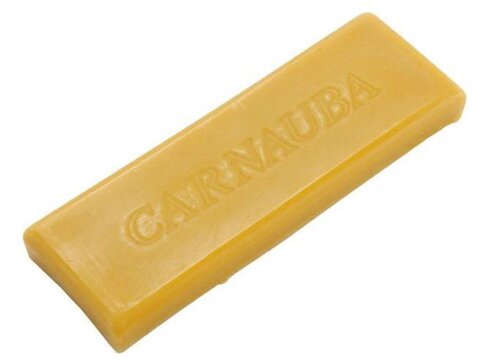
Carnauba wax or Brazil wax or the queen of waxes is one of the best non-toxic conditioners for wooden cutting boards. It comes from the leaves of the Brazilian carnauba tree (Copernicia Cerifera)
Carnauba wax is characterized by its glossy wood finish and water resistance. That’s why you will always find it in polishes, cosmetics, and automobile waxes
This magical wax is so much like beeswax but harder than it.
Cutting board or butcher block oil often mixes the wax, food grade mineral oil, and beeswax. So if you know the ingredients, why don’t you make your own product!
Buy carnauba and mix it with food-grade mineral oil or coconut one, apply on the cutting board. and ta-da you have a shiny and healthy cutting board or butcher block.
Baby oil: Can I use baby oil on my cutting board?
For those asking whether they can use baby oil on the cutting board or not, the answer is YES, you can. Baby oil is almost the same as pure food grade mineral oil with added fragrance.
Baking Soda

Okay, I know it is not oil, but it is powerful enough to have the same effect as cutting board oil. What can’t baking soda be used for anyways?!
It can remove the stains on your cutting board or butcher block. All you need to do is to sprinkle baking soda on the stains and rub it back and forth with a sponge soaked in hot water, brush, or a piece of a damp cloth.
For better results, you can sprinkle baking powder over half a lemon and start rubbing over the wood surface or stained spot.
Natural Lemon juice is also an excellent solution for removing bad smells as the ascorbic acid in a natural lemon oxidizes and reacts with bacteria and fats, causing the odor.
Let me answer a common question most cutting board owners ask which is:
Can I Use Vegetables / Olive Oil Instead of Mineral Oil?
I will get straight to the point. you should never use any cooking oils like olive oil and vegetable oil on your board. and the reason is they simply go rancid.
Rancidity is a common issue with organic oils caused by hydrolysis and autoxidation of fats. In simple terms, they will make your butcher block or cutting board sticky and gross with an unpleasant smell and taste.
Here are some examples of oils you shouldn’t use for oiling your cutting boards:
- Olive oil
- Vegetable oil
- Regular coconut oil
- Peanut oil
- Corn oil
- Sesame oil
- Teak oil
For enhanced cutting board maintenance, you also shouldn’t use rubbing alcohol, cleaning solvents, and undiluted bleach.
Should I Oil Plastic Cutting Boards?
Using regular cutting board oils, board creams, and pure food grade mineral oil for plastic cutting board maintenance doesn’t make any sense. Plastic boards are totally different from wood boards.
Wood boards can absorb the cutting board oil, while plastic surfaces won’t.
So if you noticed that the surface of your plastic material board has changed color or started to have a bad odor, here is the right way for plastic board maintenance:
- Clean it with baking powder and white vinegar
- Bring back its shine by using natural lemon juice and baking soda
- Maintain it with essential oil and vinegar
- Mix hydrogen peroxide, some drops of dish soap, and a teaspoon of baking soda and rub against the board surface.
Read also: How to Care for End Grain Cutting Board?
Final thoughts
We did imagine the harm you might get if you didn’t maintain your cutting boards regularly. That’s why we showed you the best and most efficient oils for maintaining your boards.
Actually, the previous oils also do work with any of your wood surfaces and utensils.
And here is a ground-rule you need to know if you really want to maintain your wood boards and utensils, Never bleach or soak them.
